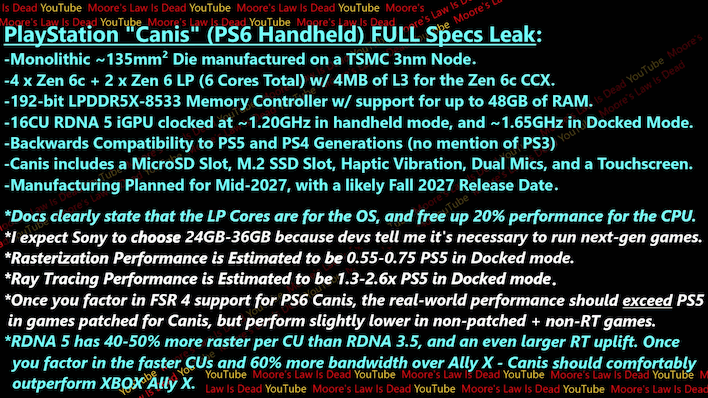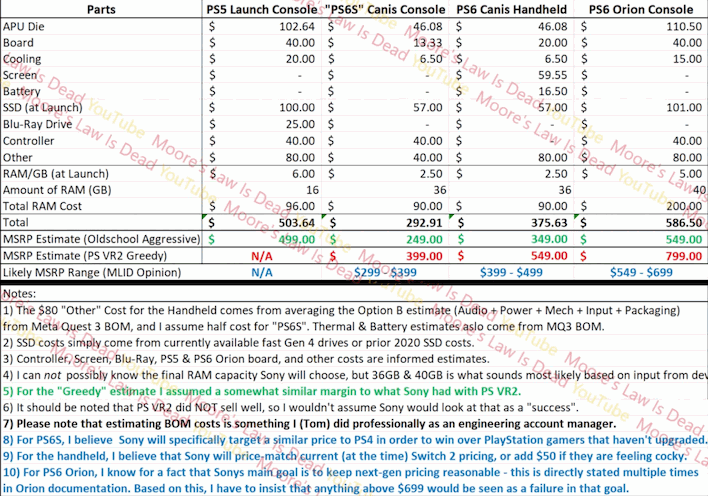Sony PlayStation 6 Canis Handheld Leak Points To A Portable Beast With Zen 6 And RDNA 5
Most of the information about 'Canis' to date has come from contentious leaker Tom of the channel Moore's Law is Dead. According to his latest leaks posted less than a day ago, the PlayStation handheld bearing 'Canis' will share architectures with the 'Orion' home console chip, using both Zen 6 CPU cores and RDNA 5 (or 'UDNA') graphics. In a sense, it may serve as the "PlayStation 6 S", similar to the Xbox Series S, in that it provides a cheaper offering for players who can't or don't want to buy the more expensive home console, yet still plays the same game.
This makes more sense than you might realize. Supposedly a major frustration for Sony is the enormous audience of players still chilling out on aging PlayStation 4s. If game developers are making games that run on the old PS4—and they are, with recent titles like Elden Ring Nightreign and the upcoming Call of Duty: Black Ops 7 both being released for the venerable platform—they're not making games that show off what the PS5 can do, and the PS5 is already five years old. A cheaper console might convince some of these gamers to finally upgrade.
According to Tom, the 'Canis' chip is going to be a small monolithic processor, about 135 mm², fabricated on TSMC's N3 process. That's considerably smaller than AMD's 'Phoenix' in the Ryzen Z1 Extreme that powers most Windows gaming handhelds; that chip is 178 mm². Canis will purportedly include four Zen 6C dense cores, and then two Zen 6 LP cores specifically for the Sony operating system.
Along with those CPUs, it will apparently also include 16 RDNA 5 compute units, fed by a 192-bit LPDDR5X memory bus. That's quite a potent GPU, considering that RDNA 5, or UDNA, is expected to be anywhere from 50 to 100% faster than the RDNA 3 architecture used in most gaming handhelds at this time. Given that, it's fair to say that this machine may only trail the PS5's raster graphics capabilities by a small amount. In ray-tracing, it should be considerably faster thanks to architectural upgrades between RDNA 2 and RDNA 5/UDNA.
The LPDDR5X memory bus is interesting, too. Given the release window, we might reasonably expect the machine to use LPDDR6, but LPDDR5X is already quite cost-effective at this time, and to enable truly next-gen experiences on the 'Canis' device, it will need a lot of RAM. According to developers that spoke with Tom, it's going to need at least 24GB of RAM to handle PlayStation 6-native games, but most of the developers expressed a wish for at least 32GB, if not more. This is in part due to a desire to incorporate large AI models, such as Large Language Models like GPT, into future games. AI is quite memory-hungry, as is ray-tracing.
A 192-bit bus at 8533 MT/s gives the machine over 200 GB/second of memory bandwidth, which is about double what the ROG Ally X has, but less than half of what the PlayStation 5 gets. Given that we're likely talking about a device with a 1080p screen, there's less emphasis to push for 4K output resolutions; for output to external displays, there's always FSR4 upscaling, so this is probably more than sufficient.
Tom goes on to speculate pricing for the upcoming device, and he believes that Sony can likely afford to equip the machine with 36GB of RAM and still bring the price in under $500. He points to his experience estimating BOM as an engineering account manager, and based on his numbers, it does look plausible. Still, we find the idea a little dubious simply based on how much other companies are charging for these devices. A 'Canis' device at even $499 would be quite a coup, as this machine's specs are better than most extant PC-based gaming handhelds, yet those systems typically cost $700 or more.
He also speculates about the potential for a "PS6S" based on Canis; this would be something like the old PlayStation TV, which was essentially a PS Vita without an integrated screen, speakers, or controls; you hooked it up to a TV like a regular console. He speculates that Sony could bring out such a device as cheap as $299, the same as the launch price for the Xbox Series S. It's an interesting idea, to be sure.
We haven't gone over everything Tom talks about in his video; if you're curious to see the rest of the specs as well as more speculation on the future of PlayStation and AMD's graphics plans, hit up the video on YouTube.



